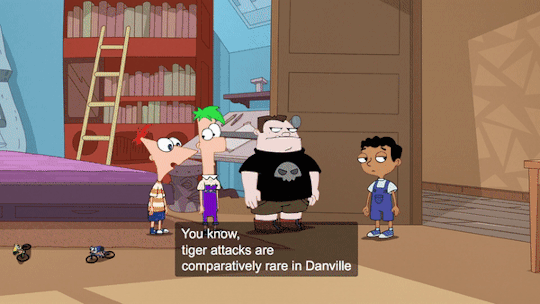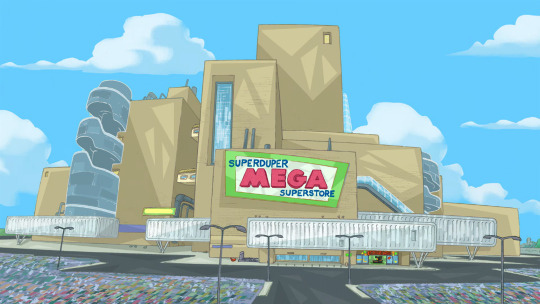#return policy
Photo


#phineas and ferb#pnf#return policy#phinabella#phinbella#*#100*#we don't talk enough abt isabella's bloodthirst
272 notes
·
View notes
Photo



Phineas and Ferb take invention requests from the citizens of Danville.
278 notes
·
View notes
Text
Lotsa Latkes vs. Return Policy


Lotsa Latkes
Summary: When all the potatoes in Danville go missing, Phineas and Ferb decide to clone some using Buford's last potato chip so that Isabella's Nana can make latkes for the Latke Festival. Unfortunately, Buford's DNA merges with the potatoes, creating mischievous Potato Gremlins all over town. Meanwhile, Dr. Doofenshmirtz plans on using his "Historical Army Retrieve-inator" to summon the Spartan army and command them to take over the Tri-State Area.
Personal highlights: FRENEMIES
Return Policy
Summary: Annoyed at waiting in really long lines at the return counter, Doofenshmirtz invents a "Back-to-the-Store-inator" to send things back to the store where they came. Meanwhile, Phineas and Ferb stage an extreme batting challenge their friends take place in, and Candace's obsession to bust coincides with her and Jeremy's visit to the Extreme Water Park.
Personal highlights: PENNIES, the logical extension of the Back-to-the-Store-Inator and the continuity that neither of Doof's parents showed up for his birth
#pnf#pnf episodes#pnf episodes tournament#phineas and ferb#dwampyverse#poll#poll tournament#tournament poll#poll bracket#dwampyverse tournament#lotsa latkes#return policy
10 notes
·
View notes
Text


It ain’t mild or moderate, or safe or secure
It ain’t meek or mellow, docile or demure
It ain’t peaceful or placid, or sedate or serene
What it is is EX-EX-EX-EXTREMELY EXTREME! 😎
(Because we ALL KNOW the truth - Isabella is absolutely the lead vocalist of “Extremely Extreme” 😆)
#phineas and ferb#pnf#isabella garcia shapiro#novembella 2022#novembella#phineas flynn#phinabella#phinbella#prompt list#return policy#2 passion
21 notes
·
View notes
Text
NewMe Asia's return policy ensures customer satisfaction. Unused items in original packaging can be returned within [X days/weeks/months] for a refund or exchange. Contact customer service for a return authorization. Customers are responsible for return shipping costs unless the item is defective or there was a mistake in the order. Refunds are processed to the original payment method. Exceptions may apply. For inquiries, reach out to our customer service team. Thank you for choosing NewMe Asia; we aim to provide a seamless shopping experience.
1 note
·
View note
Text
0 notes
Link
Refund and Return Policy Fortune Forest wishes its customers the best shopping experience to enhance their lives. As opened or used products cannot be reused or resold, the items cannot be returned to the seller once delivered. In extreme cases of damaged product delivery (leakage / broken / missing items) due to transit, a refund
0 notes
Text
online shopping : a comprehensive guide
INTRODUCTION
Electronic commerce, sometimes known as e-commerce, is the term used to describe the purchasing and selling of goods and services via the Internet, websites, mobile applications, or other digital media. It encompasses a variety of activities, including digital marketing, electronic payments, and online purchasing.
Online shopping is the act of buying products or services over the Internet, typically through an e-commerce platform. This can entail looking through and choosing things, placing them in a digital shopping cart, and completing the deal with an online payment system. Internet shopping is convenient and flexible because it enables customers to make purchases whenever and from wherever they are, without having to physically go to a store.
The use of electronic data interchange (EDI) by businesses to exchange business papers marked the beginning of electronic commerce in the 1960s.
The development of the Internet and the World Wide Web in the 1980s paved the way for the first online retail websites to appear. One of the earliest instances is the 1994-founded online book retailer Amazon. eBay, which started off in 1995 as an online auction site, and PayPal, which was established in 1998 to offer safe online payment processing, are two other early examples of e-commerce websites.
With the development of social media platforms, online marketplaces, and mobile commerce in the 2000s, e-commerce expanded quickly.
Today, e-commerce is a global industry, with billions of customers worldwide using the Internet to buy a wide range of goods and services.
The development of e-commerce, its effects on the retail sector, consumer behavior, online shopping, and the future of e-commerce.
I. Growth of e-commerce
I.1. Elements for e-commerce growth: Advances in technology
The development of e-commerce has been significantly influenced by technological advancements. Following are a few of the significant technological advancements that have contributed to the expansion of e-commerce:
Faster Internet connections: The widespread availability of dependable and quick Internet connections has aided in the expansion of e-commerce. Thanks to better internet speeds, businesses may now provide a seamless online buying experience with high-quality photos and videos and quick load times.
Mobile Devices: The widespread use of smartphones and tablets has helped e-commerce flourish. Consumers may now shop online at any time and from any location thanks to mobile devices, and businesses can also provide mobile-friendly websites and applications.
Cloud computing: As a result of cloud computing, it is now simpler and more affordable for organizations to store, process, and scale up their operations as they expand. Because of this, businesses of all sizes are now able to provide e-commerce solutions without having to spend money on costly IT infrastructure.
Artificial intelligence and machine learning developments have made it possible for companies to tailor the online shopping experience for each customer based on their interests and behavior.
Payment processing: The development of safe and practical online payment processing systems, such as credit card processing, PayPal, and other digital payment methods, has aided in the expansion of e-commerce. Making online purchases has become simpler and safer for customers thanks to these payment methods.
I.2. Elements for e-commerce growth: Proliferation of mobile devices
One of the main factors influencing the expansion of e-commerce in recent years has been the proliferation of mobile devices. Following are some instances of how the rise of e-commerce has been influenced by mobile devices:
The use of mobile internet has significantly increased as a result of the increasing adoption of smartphones and tablets. Consumers may now browse and shop online using their mobile devices and have access to the internet at any time and from any location.
Mobile applications: Connecting with clients and generating sales with mobile applications is a growing trend for organizations.
Mobile wallets and payment apps are only two examples of the mobile payment possibilities that have emerged as a result of the proliferation of mobile devices.
Mobile advertising has significantly increased as a result of the growth of mobile devices. Businesses can now target consumers with mobile ads that are specific to their interests and behavior.
Social Media: Online social networking sites like Facebook, Instagram, and Twitter have grown to be crucial sales channels for e-commerce.
I.3 Factors driving e-commerce growth: Popularity of online marketplaces
The emergence of online marketplaces is a significant influence on e-commerce.
Increased product variety: Compared to traditional physical stores, online marketplaces give customers access to a larger choice of goods.
Pricing competition: Internet marketplaces are renowned for their pricing competition, as vendors seek to give customers the greatest deals.
Convenience: Online marketplaces make it easy for customers to shop by letting them browse and buy products from a variety of merchants all in one location.
Trust and Reliability: To ensure the trust and dependability of the platform, several online marketplaces include buyer protection programs and other safeguards.
Global reach: Internet marketplaces have made it possible for companies to connect with clients on a global scale, creating new opportunities and fostering the expansion of e-commerce.
I.4. Statistics of the growth of e-commerce
Recent years have seen a tremendous increase in e-commerce, and this growth is projected to continue. These are some figures that demonstrate the size of the e-commerce growth:
By 2023, global e-commerce revenue is projected to increase from $3.53 trillion to $6.54 trillion. This is equivalent to an 18.1% compound annual growth rate (CAGR) (source: Statista).
E-commerce sales surged dramatically as a result of consumers changing their online shopping habits during the COVID-19 pandemic. E-commerce sales in the United States grew 44% in 2020 to $861 billion (source: Digital Commerce 360).
M-commerce, or mobile commerce, is also expanding quickly. M-commerce sales increased from 35.7% in 2018 to 45.1% of total global e-commerce sales in 2020. (source: Statista).
With 62.4% of all e-commerce sales occurring in the world's largest market, Asia-Pacific, in 2020 (source: eMarketer).
With projected net revenues of $386 billion in 2020, Amazon will be the largest e-commerce corporation in the world. Alibaba, JD.com, and Walmart are additional significant companies in the e-commerce sector (source: eMarketer).
I.5 . Comparison of e-commerce and traditional retail sales
Here is a contrast between traditional retail and e-commerce:
Convenience: One of e-main commerce's benefits is how convenient it is. Unlike traditional retail, which requires customers to physically visit a store during business hours, internet retail allows people to shop from anywhere, at any time, and via any device.
Choice: Compared to traditional retail, e-commerce provides a broader range of products. Internet merchants can provide a greater variety of products than traditional shops since they are not constrained by physical store space.
Price: Because e-commerce has a smaller overhead and more direct sales to customers than traditional retail, it frequently offers lower costs.
Personalization: With experienced employees and the chance to touch and test things, traditional retail can provide a more individualized buying experience. By targeting advertising and product recommendations based on user data, e-commerce can also provide increased customization.
Order fulfillment: As shipping and delivery services are frequently needed in e-commerce, clients may have to wait longer. With quick gratification provided by traditional retail, buyers can leave the store with their goods in hand.
Customer Experience: The general customer experience varies between traditional retail and e-commerce. E-commerce may provide a more streamlined and effective experience, whereas conventional retail may provide a more interesting and social one.
II. Impact on the retail industry
Competition from online stores is one of the main problems facing traditional retailers today.
Consumer behavior is evolving: As e-commerce has grown, consumers' preferences for online shopping have changed.
High operational expenses: Conventional brick-and-mortar stores have expensive overhead expenses like rent, utilities, and employee pay.
Conventional merchants must forecast demand and supply their storefronts appropriately, which presents inventory management challenges.
Restricted geographic reach: Because they can only draw clients from a specific area around their locations, traditional retailers may have a limited geographic reach.
Having trouble adjusting to trends: Conventional retailers may have trouble adjusting to shifting consumer preferences and trends.
The capacity to swiftly and easily compare prices is one of the key advantages of online buying. Customers may find the best deal quickly and buy the item from the online merchant with the best price. Because of this, traditional retail establishments find it difficult to stay competitive and frequently have to decrease their prices.
The employment situation in the retail industry has been significantly impacted by the growth of e-commerce and online shopping. Traditional retail establishments are experiencing diminishing revenues as more and more people purchase online, and they are frequently compelled to close their doors as a result. Several store employees have lost their jobs as a result of this.
In addition, the growth of e-commerce has opened up new career prospects in industries like shipping, logistics, and warehousing. Compared to traditional retailers, e-commerce retailers need a different set of skills and knowledge, and many of these professions call for specific training and education.
III. Consumer behavior and online shopping
For businesses to sell their goods and services successfully, cultivate client loyalty, and enhance the overall customer experience, they must have a solid understanding of consumer behavior.
Convenience is one of the major variables influencing consumer behavior when shopping online. Customers appreciate the ease of online shopping since it allows them to browse and buy goods without leaving the comfort of their homes.
Price is another significant aspect that affects consumer behavior while shopping online. Due to their high price sensitivity, consumers frequently evaluate prices across several e-commerce sites to get the best offer.
The simplicity with which e-commerce platforms can be used and navigated has an impact on consumer behavior as well. Platforms that are simple to use, have clear navigation and enable a quick checkout are preferred by customers.
Ultimately, online reviews and social proof have an impact on customer behavior. While making judgments about what to buy, consumers frequently go to reviews and advice from other shoppers. Negative reviews can significantly influence consumer behavior, but positive reviews and high ratings can increase credibility and confidence.
IV. Future of e-commerce
The future of e-commerce is dynamic and exciting, and many trends and advancements are anticipated to influence the sector in the years to come. The following are some of the major developments and e-commerce forecasts for the future:
Mobile commerce: As the use of smartphones and tablets rises, this sector of the e-commerce market is expected to become increasingly dominating.
Artificial intelligence: The e-commerce sector is poised to undergo a transformation thanks to the use of artificial intelligence (AI), with many businesses already utilizing chatbots and personalized product recommendations powered by AI to improve the customer experience.
Augmented Reality: With businesses embracing AR technology to offer virtual product demonstrations and trial experiences, augmented reality (AR) is also expected to play a significant role in the future of e-commerce.
Sustainability: Due to rising environmental and social responsibility awareness, e-commerce businesses are likely to prioritize sustainability in the future.
Delivery alternatives: As businesses take into account new delivery models like same-day delivery, drone delivery, and even autonomous delivery vehicles, delivery options are also expected to change.
CONCLUSION
In summary, e-commerce and online shopping have revolutionized how we purchase and sell goods and have grown to be a critical component of the world economy. The proliferation of mobile devices, technological advancements, and the acceptance of online markets have all contributed to the expansion of e-commerce. This growth has significantly impacted the retail industry, and traditional brick-and-mortar merchants are finding it difficult to keep up with shifting consumer tastes and the emergence of new retail models.
The ease, accessibility, and personalization that online shopping offers, as well as the availability of product information and reviews, have all had an impact on consumer behavior. E-commerce has a promising future, with ongoing growth and expansion into new markets and regions. Yet, there are also difficulties and barriers to getting over, such as market saturation, increasing competition, environmental impact, and security and fraud prevention.
#E-commerce#Online shopping#Digital commerce#Internet shopping#Virtual storefront#Shopping cart#Product search#Payment gateway#Mobile shopping#Customer reviews#Comparison shopping#Product information#Product delivery#Return policy#Customer service
1 note
·
View note
Photo

(via JioMart Refund & Return Policy: How to Get Back Money of your Order)
0 notes
Text
There are too many episodes to seed. Please help me out (12)
#pnf episodes#pnf episodes tournament#phineas and ferb#dwampyverse#poll#poll tournament#tournament poll#poll bracket#dwampyverse tournament#preliminary polls#quietest day ever#raging bully#ready for the bettys#return policy#robot rodeo#run away runway#run candace run#sci-fi pie fly#she's the mayor#skiddley whiffers#sleepwalk surprise#spa day
6 notes
·
View notes
Link
Well, thank F***! And the Authors’ Guild. :)
Spread the news far and wide, friends.
4K notes
·
View notes
Text

He already burned the receipt sorry Steve
#harringrove#theres no return policy for him and now you’re bonded forever#billy hargrove#steve harrington#billy x steve#billy hargrove x steve harrington#incorrect harringrove quotes#harringroveera#harringrove textpost#incorrect billy hargrove quotes#incorrect steve harrington#harringrove meme#steve x billy#steve harrington meme#billy hargrove meme#harringrove edit#steve harrington x billy hargrove
122 notes
·
View notes
Text
Literally dragged my sorry ass to work for a 10am meeting and the guy didn't even fuckin show up
Answer your mfing email or I am going to hunt you for sport sir, I know I am obsessive and type A anxious perfectionist but how the FUCK do real adults and businesses function like this. I'm stressing about having my life together and being employed and all that jazz, and AT LEAST I RESPOND TO MY WORK CORRESPONDENCE
#SMH. SMH. THIS COMPANY IS NOT GETTING THE CONTRACT#i have been HUNTING THEM DOWN and they cant even fuckin show up#booo i have to get 3 quotes bc policy. i get why#but when half the companies cannot even be remotely reliable#obvs i am going with the guy who actually fuckin returns my calls and emails#LOUIS FROM REDACTED COMPANY YOU ARE THE ONLY VALID MFER IN THE WORLD TO ME RN#the duality of fran
35 notes
·
View notes
Text

Ebay
73 notes
·
View notes
